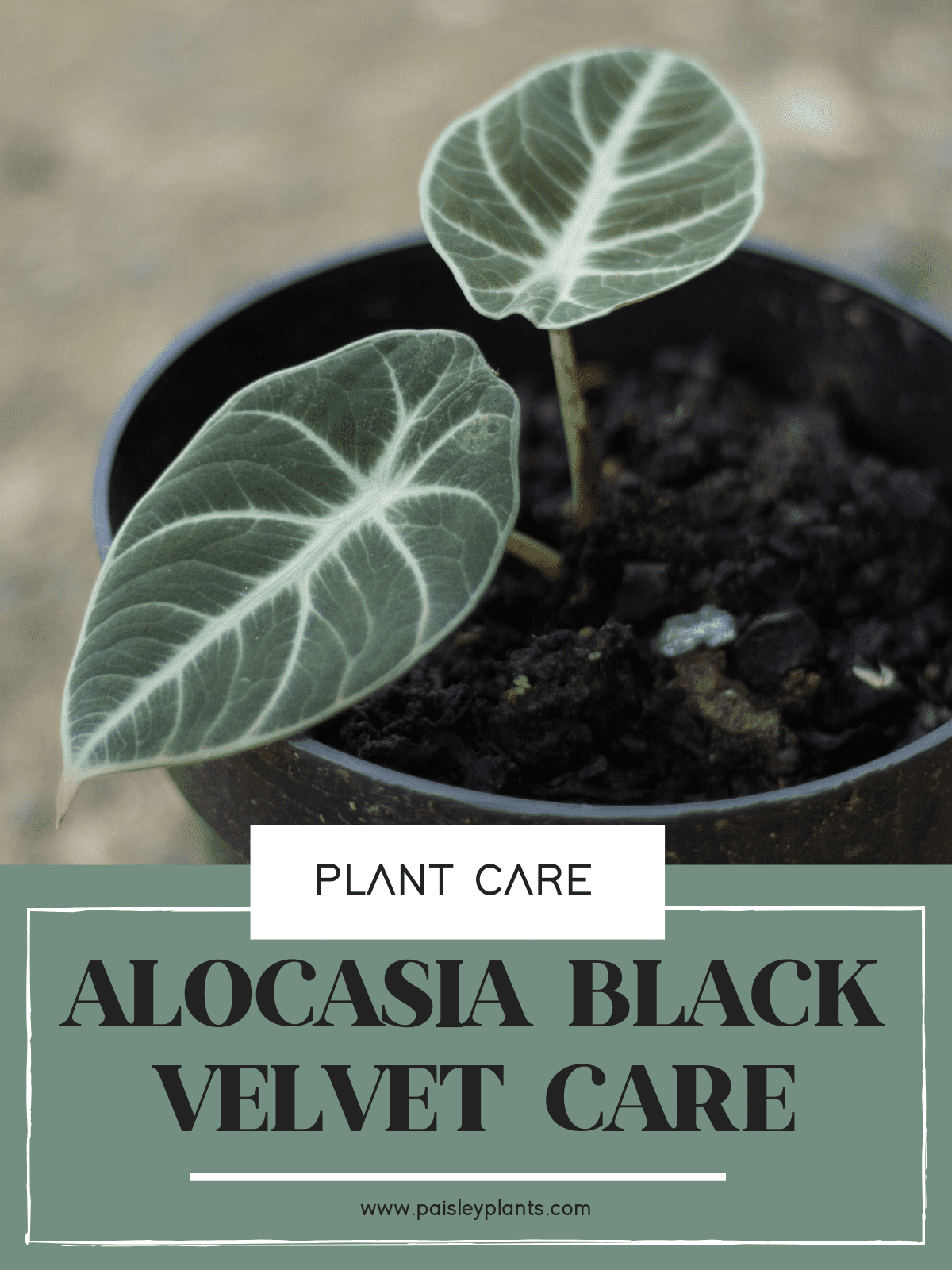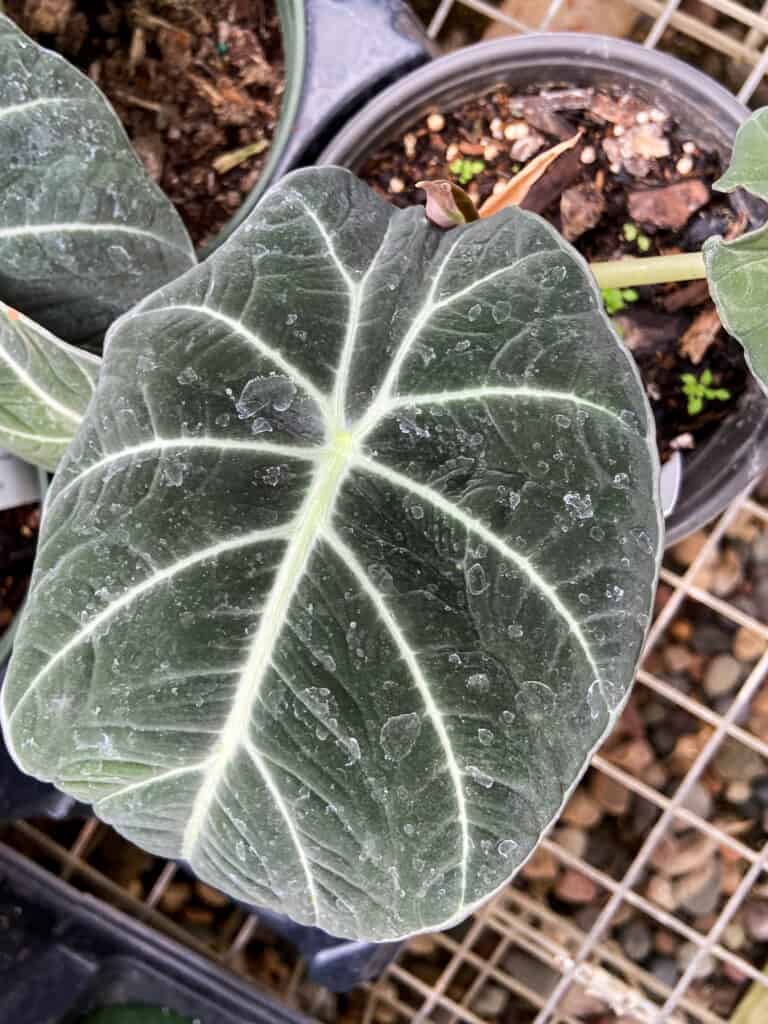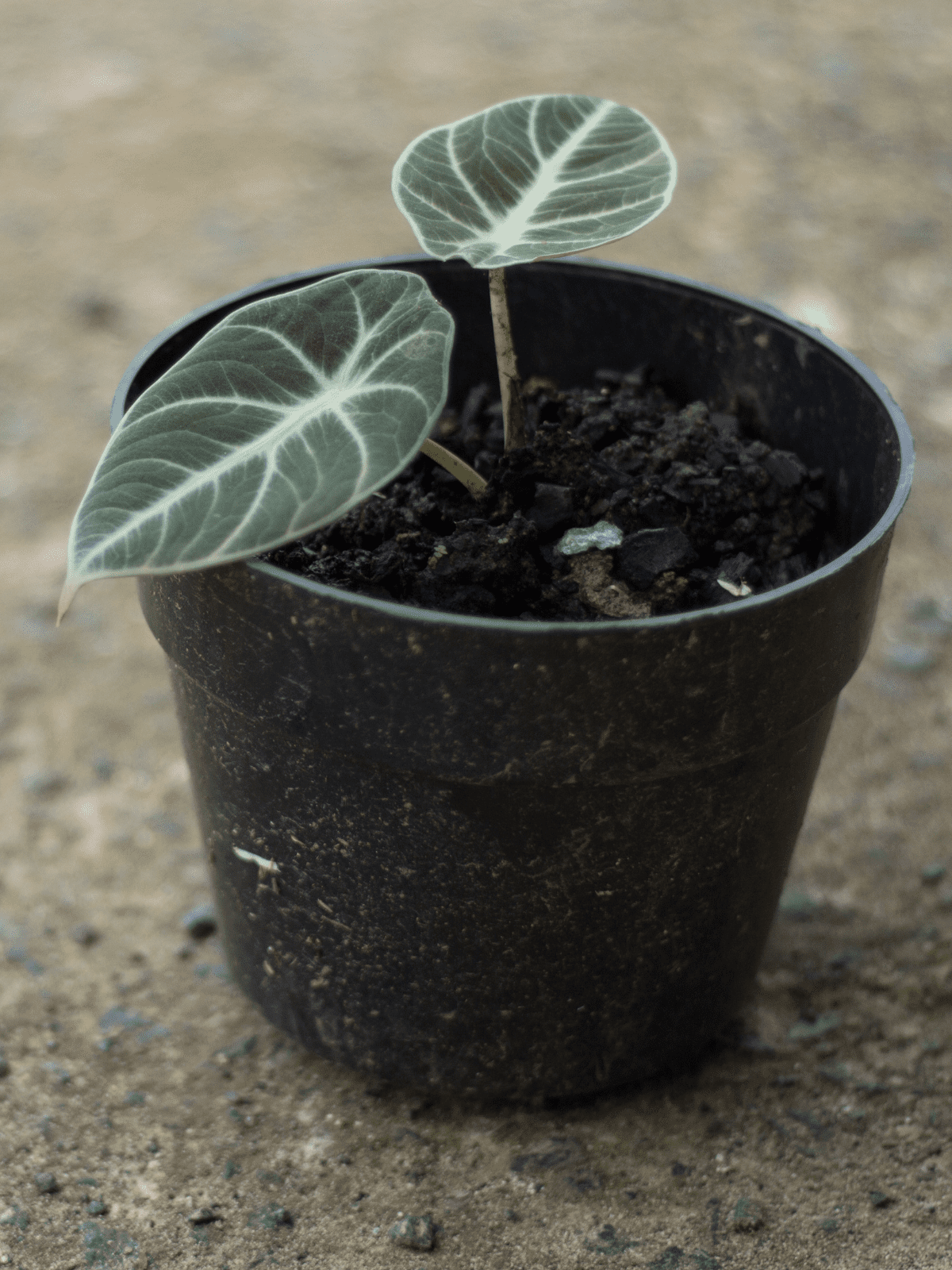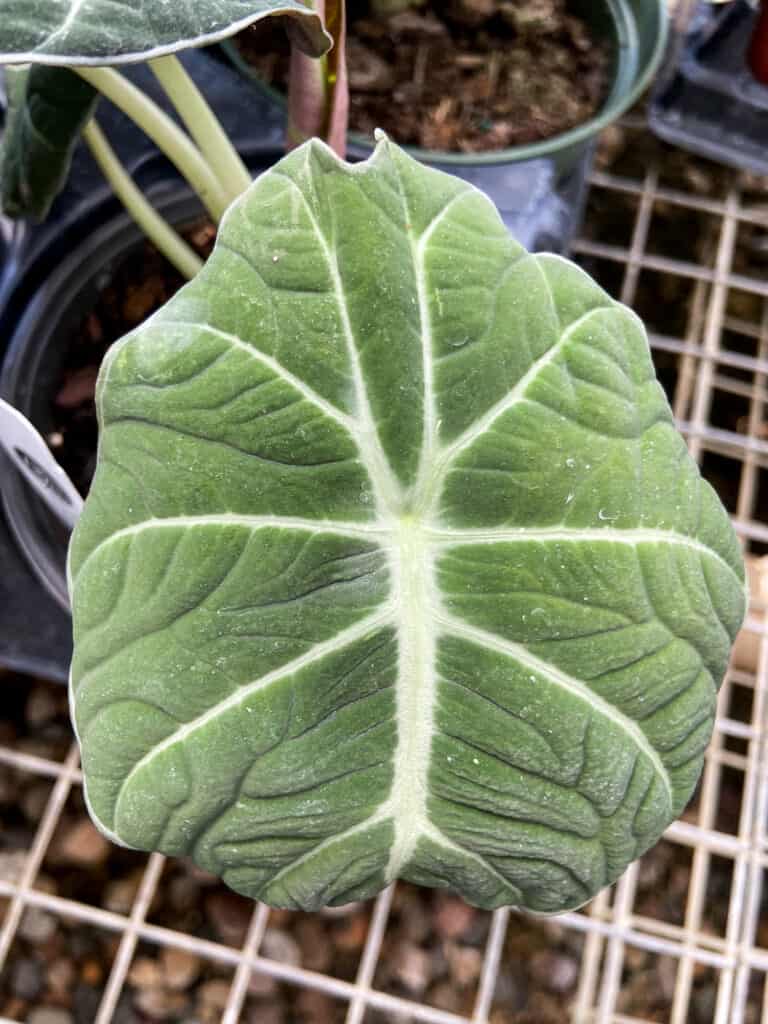Alluring and beautiful, the alocasia black velvet is one of the most eye-catching houseplants available on the market. While they have some lofty care expectations, I’m sure you’ll find that these plants are as easy to care for as any other plant!
Read on to learn more about how to care for the alocasia black velvet.

This post includes affiliate links.
Table of Contents
Background
The Alocasia reginula, otherwise known as the alocasia black velvet is a beautiful tropical houseplant that is originally native to Borneo in Southeast Asia.
Like many plants in the Alocasia genus, the black velvet is identifiable by their large arrow-shaped leaves. In fact, these plants are commonly called the “elephant ear” plant due to the shape of the leaves, which bear a resemblance to elephant ears.
The black velvet leaves are particularly beautiful; the dark green leaves are contrasted by their silver veins. Often times their leaves will be so dark they will almost appear black. The black leaves is how this plant gets its name. The alocasia black velvet is so sought-after due to their gorgeous foliage.
The black velvet is smaller and slower growing than other members of the Alocasia genus. At maturity, the black velvet only grows to about 18 inches tall.
While this is a beautiful plant to have in your home, it is toxic to both humans and pets. If you do own a black velvet, it is best to exercise extreme caution and keep these plants out of reach from small children and pets.
Alocasia Black Velvet Care Tips

Let’s talk about all you need to know about Alocasia Black Velvet care. Here’s all the tips and tricks you need for a happy Alocasia.
Sun & Light
In their native habitat, the Alocasia Reginula lives under the thick canopy of the tropical jungle. They receive bright, yet indirect light, and it is important for plant owners to replicate these light conditions.
Try to avoid placing your black velvet in a location that receives too intense light, otherwise their signature hue will suffer. On the flip side, insufficient light causes scraggly, leggy growth. I have my Alocsaia on a shelf where it gets dappled light from a north facing window and she seems to like that!
Soil Type
The ideal soil for a black velvet alocasia is one that can retain even moisture, while draining out the excess. Select a potting mix tailored for tropical plants that contain materials such as bark, loam, or sand.
Avoid mixes that have high concentrations of peat moss and coco coir; while these have their benefits, too much of it can cause the soil to become too wet.
Black Velvet Watering Preferences

Moving on to Black Velvet watering tips. Knowing the right amount of water your plant needs to create the best environment is one of the hardest but most crucial care steps for growing one of these plants!
Keeping your alocasia’s soil adequately moist is one of the trickiest parts of caring for these unique plants. The alocasia likes an evenly moist soil, but they do not like having wet feet (too much water).
The best rule of thumb to know when to water your black velvet is to wait until the top few inches of soil have dried before you water your plant’s soil. If you stick your finger into the soil and it’s dry and no dirt sticks to your finger, it’s time to water it. However, if your finger holds some dirt on it or it feels wet to the touch, don’t water it!
During the wintertime (when your plant is in dormancy), it is recommended to wait to water it even longer, when the soil is nearly dried out.
Black Velvet plants can also withstand a bit less water than other Alocasia plants given their thick leaves. If you have other Alocasia plants just keep that in mind when watering them!
Fertilizer
Alocasias are notorious slow-growing plants, but a regular light fertilizer routine is helpful in encouraging strong growth during its active growing period.
During the spring and summer, treat your plant with a balanced liquid fertilizer that is specially made for houseplants. This fertilizer should be applied every two weeks. Stop using fertilizer entirely during the fall and winter.
Temperature & Humidity
The alocasia black velvet is a tropical plant, so it comes as no surprise that they enjoy a warm, humid environment. The ideal temperature for the black velvet is at least 70° F, which is more than attainable for indoor plant owners. Do not allow the temperature to dip below 60° F, and avoid placing your black velvet in a drafty location such as near an air conditioning vent.
Humidity plays an equally important role in maintaining the perfect environment for your plant. Your black velvet will be most comfortable with an air humidity level above 50%. If you’re concerned about low air humidity, placing an air humidifier in the same room as your alocasia is an easy way to increase the humidity level.

Pruning & Maintenance
Because the alocasia black velvet is such a slow-growing plant, you will not have to prune your plant very often. That being said, it is important to prune whenever you notice dead or damaged foliage. Always make sure that you are using a pair of sharp, sterile scissors when you prune your plants, as residual bacteria can spread from your shears to your plant.
Choosing a Container & Repotting Your Alocasia
The most important aspect of choosing a container for your alocasia is drainage. You’ll want to make sure your plant pot has plenty of drainage holes at the bottom. Drainage holes allow for excess soil moisture to pass through, which keeps your plant comfortably hydrated without being waterlogged.
Since they are slow growing plants that enjoy being slightly root-bound, the alocasia velvet does not have to be repotted very often. Most likely, you can expect having to repot these plants every 2 years.
How to Propagate an Alocasia Black Velvet
Alocasia black velvet plants cannot be propagated by stem or leaf cuttings. These plants grow rhizomes under the soil, which produce new shoots. These shoots can be cut off to repot and produce a new reginula. Follow these straightforward steps to learn more:
- The best time to split the rhizomes apart of your plant is at the beginning of spring, just as your alocasia is entering its active growing period.
- Wear protective gloves, as alocasias can cause skin irritation.
- Slide the plant out of its pot and dust off the soil, exposing the rhizome and the shoots.
- Using a sharp knife, cut off a few offshoots from the main rhizome.
- Place the cuttings in a plant pot filled with moist potting mix. Place your pots in a location that is warm, humid, and bright.
- It takes nearly a month for rooting to occur. After that, it takes an additional few weeks for new growth to appear. Remember, the black velvet is slow-growing, so don’t feel discouraged if you think the propagation did not work!
Common Pests in Alocasia Plants

For the most part, the alcoasia is not prone to many houseplant pests. However, you may encounter an infestation of spider mites. Spider mites are small sap-sucking pests that leave your alocasia leaves looking sickly with yellow/white stippling marks all over.
Fortunately, spider mites are very treatable when caught early. First and foremost, you should prune any foliage on your black velvet that has been damaged by the spider mites. Spraying your alocasia with neem oil is an effective and natural approach to controlling these pests.
In addition, spider mites usually appear when the air humidity is dry. To keep these pests at bay, try to maintain a humidity level of over 50%.
Common Diseases
As we’ve discussed previously, watering a Reginula can be rather tricky. It’s understandably hard to balance a soil that likes its soil moist, but not too moist. Unfortunately, in situations like this, alocasia plants can be at a higher risk of root rot. Excess moisture can become trapped in the soil, which eventually harbors bacteria and breaks down the roots. Root rot can be treated if plant owners act quickly. Telltale signs of root rot include wilting, yellowing foliage.
Follow these steps to help combat root rot:
- Remove your alocasia from its pot and gently shake away excess dirt.
- Inspect the roots; rotted roots are mushy and black compared to the firm, off-white color of healthy roots.
- Take a sterile pair of scissors and cut off any rotted roots you see.
- Repot your alocasia using clean, new soil in a pot that has drainage holes
Where to Buy
You can buy a Black Velvet here:
Black Velvet Alocasia FAQ
The most common reason that the leaves on your alocasia plant are curling is likely due to not enough humidity and under watering. You could also double check the amount of light that your alocasia is getting. If it’s not getting enough light that can also make your alocasia leaves curl.
On the other hand, if the leaves look scorched or burnt, and they’re curling, this is a sign that your plant is getting too much light. Too much direct light is bad for Black Velvet plantss and will result in burnt, curling leaves
If your plants leaves are dying don’t worry! It’s a natural thing that happens as the leaves get older. All you need to do is carefully trim them off and move on.
One thing to double check though is if your leaves are turning yellow prior to dying. If that’s the case, there’s a chance you’re over or under watering your plant.
Keep an eye on whether the soil is dry or wet before you water it the next time to give yourself an idea of if you’re over or under watering. Too much or too little water can cause your plant to loose leaves prematurely.
Yes, the alocasia black velvet is indeed a very rare plant. These plants seldom grow in the wild, and rely on specialty cultivators to reproduce them.
If your alocasia black velvet is producing flowers, then I suggest you give yourself a pat on the back! Flowering is the ultimate sign that your plant is thriving in optimal conditions.
The downside is that the flowers on this plant aren’t particularly spectacular. These plants are primarily purchased for their beautiful leaves not their flowers. Regardless, you should be very proud of making your houseplant flower and keep up the good work.
This is mostly dependent on the quality of care that the plant receives. The Reginula is not a fast growing houseplant, and you can expect a black velvet to become fully mature within 2 to 5 years. With some of the best care you can see your plant growing faster.
The alocasia black velvet is a rare plant, but that doesn’t mean that they are difficult to care for! I hope these care tips and tricks help you in raising a happy, healthy plant in your home garden that will bring you tons of joy for years to come.
With a little love and care, you can have a beautiful thriving Alocasia plant in your home that will live on for years to come. If you come across the opportunity to own this tropical plant, do not pass it up!
If you want other fun plants like the Alocasia plant, check out these 9 stunning plants with big leaves to add some fun to your home!

